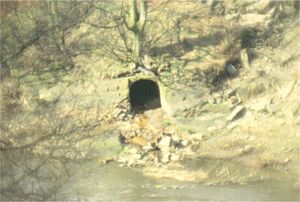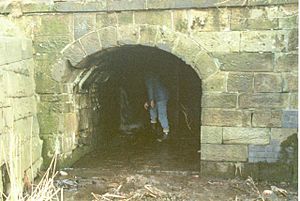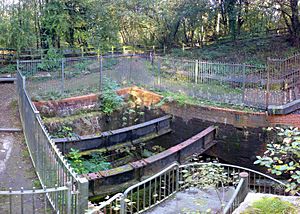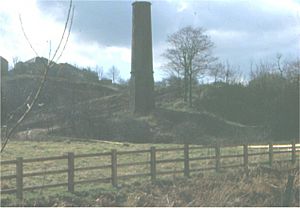Wet Earth Colliery facts for kids
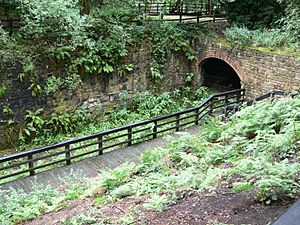
Canal entrance to the colliery
|
|
| Location | |
|---|---|
| Location | Clifton, Greater Manchester |
| Country | United Kingdom |
| Production | |
| Products | Coal |
| Type | Underground |
| History | |
| Opened | 1740s |
| Closed | 1928 |
The Wet Earth Colliery was an old coal mine in Clifton, Greater Manchester. Today, the area is part of Clifton Country Park. This mine is special because it was one of the first deep coal mines in Britain. It's also famous for a clever trick by engineer James Brindley, who found a way to make water flow uphill to help the mine.
Contents
Why Coal Was Easy to Find Here
The Wet Earth Colliery was built in the Irwell Valley, near the River Irwell. This river flows along a big crack in the Earth's crust called the Pendleton Fault. This fault pushed up the deep layers of coal, making them easier for miners to reach. On one side of the fault, there was red sandstone. On the other side, the coal layers were closer to the surface.
A Look Back: The Mine's Story
Early Days of Mining
People started digging for coal in this area a very long time ago. The first deeper mine was started in the 1740s by John Heathcote, who owned the land. He dug two shafts, about 50 feet (15 meters) deep, to reach a coal layer called the "Doe mine." This coal layer was very thick, almost 10 feet (3 meters)!
In 1751, Heathcote started a new, deeper shaft for the Wet Earth Colliery. But he ran into big problems, especially with water flooding the mine. He needed help from an expert.
Water, Water Everywhere: 1750–1804
Matthew Fletcher, a mine owner and engineer, came to help. He dug a new shaft 262 feet (80 meters) deep, which became the main part of the Wet Earth mine. Later, he made it even deeper, 328 feet (100 meters), to reach another coal layer. But water kept pouring into the mine from the River Irwell through the Pendleton Fault. Heathcote closed the mine in 1750 because of the flooding.
That's when James Brindley stepped in. Brindley was a famous engineer known for building canals, like the Bridgewater Canal. He had a brilliant idea to remove the water using water power. The challenge was that the mine was 23 feet (7 meters) higher than the river, so water couldn't just flow into it.
Brindley solved this by building a small dam (a weir) upstream on the River Irwell. This raised the water level. Then, he dug a long tunnel, 800 yards (730 meters) long, through rock. This tunnel went under a big bend in the river. At one point, he dug two shafts and connected them with a 73-yard (67-meter) tunnel under the river, creating an "inverted siphon." This is like a giant U-shaped pipe that lets water flow under something, then rise up again.
From the siphon, an open channel (called a "leat") was dug. This channel carried water 235 yards (215 meters) to the mine.
Inside the mine, the water turned a huge 23-foot (7-meter) waterwheel. This wheel powered a "nodding donkey" pump, which lifted the water out of the mine. The used water then flowed back into the Irwell through another tunnel.
This amazing system was built between 1752 and 1756. It worked so well that it was used for 170 years! The original waterwheel was later replaced by a more modern water turbine in 1867.
After the mine reopened, Matthew Fletcher took over ownership. He dug a new, wider shaft called "Gal Pit," which was 159 feet (48 meters) deep. It was named after the "Galloway ponies" used to pull coal carts.
By 1791, a canal was built to connect Wet Earth Colliery to another mine, Botany Bay Colliery. Fletcher then linked this canal to the Manchester Bolton & Bury Canal. This meant coal could be loaded directly onto barges at the mine and shipped all the way to Manchester, about 6 miles (10 km) away. This section of the canal became known as Fletcher's Canal.
More Growth and Changes: 1804–1880
In 1804, Matthew Fletcher's nephew, Ellis Fletcher, dug a second shaft and added a steam-powered engine to help lift coal. This new shaft greatly improved the mine, making it easier to get coal out and improving air flow. The old horse-powered lifting system was no longer needed.
After Ellis died in 1834, his sons took over. However, they lost interest in the mine, and it barely kept going. By 1880, most of the coal layers were used up. The Fletcher family sold the mine to the Pilkington brothers.
Around this time, in 1838, the Manchester and Bolton Railway opened, and a train station was built close to the colliery.
The Final Years: 1880–1928
The Pilkington brothers brought new life to the mine. They replaced old equipment and doubled the amount of coal produced. They even formed a new company, the Clifton and Kersley Coal Company. They made Ellis Fletcher's shaft even deeper, reaching 607 feet (185 meters) to get to the "Trencherbone mine" coal layer.
More coal layers were dug during this time. In 1910, a tunnel was built to connect to another mine, the Plodder Mine. This gave the colliery more coal to dig, but then the river found a crack in the fault and flooded it.
Other coal layers were also running out. After a miners' strike in 1921, the mine slowly shut down and finally closed in 1928.
Wet Earth Colliery Today
After the mine closed, the area was left empty. Over the years, some parts were removed, but you can still see where the mine used to be. Salford City Council has turned the area into Clifton Country Park. They have worked to fix up what's left and created walking trails. You can walk along Fletcher's Canal, see the river workings from Brindley's clever siphon, and visit the spot where the Gal Pit once stood (it's now covered for safety). A group called the Wet Earth Colliery Exploration Group has even dug up and restored parts of the old pumping system.


